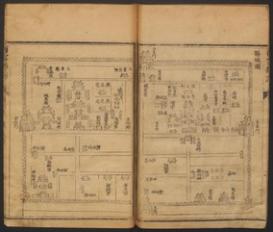The Chinese physician Zhang Jiebin 張介賓 (1563–1640) wove connections between medicine and divination throughout his three-part medical treatise, the Classified Canon (Leijing 類經, 1624). His essay “The Meaning of Medical Divination” (Yiyiyi 醫易義) began with the quote “[If one] does not understand divination (yi 易), [then one] cannot be called a great physician (taiyi 太醫)” and then argued that both fields have the same origin, similar ends, and comparable predictive methods. This project asks how these two domains became so intertwined by Zhang’s time. Not only did the new social identity of doctor-diviners (yibu 醫卜) expand, newly combined yin-yang medical schools (Yinyang yixue 陰陽醫學) were also established.
The city map above published in a 1673 local gazetteer from Nangong prefecture in Hebei province demonstrates this second development. Among the four medical institutions listed, the yin-yang medical school is prominent. The upper left-hand corner inside the city wall lists together the Nurture-and-Relieve Almshouse (Yangji yuan 養濟院) for the poor and the Three Progenitors Temple (Sanhuang miao 三皇廟) for worshiping medical sages of antiquity. Along the southern wall is the Epidemic Gods Temple (Wenshen miao 瘟神廟). The large multi-building complex in between is the prefectural yamen. Listed to its right, among other state-sponsored institutions, is the yin-yang medical school. These broader social and institutional transformations comprise the cultural manifold within which Zhang integrated hand-based divination methods into a new medical synthesis.

